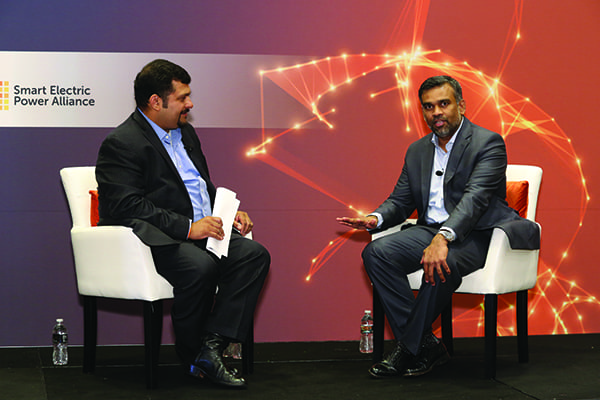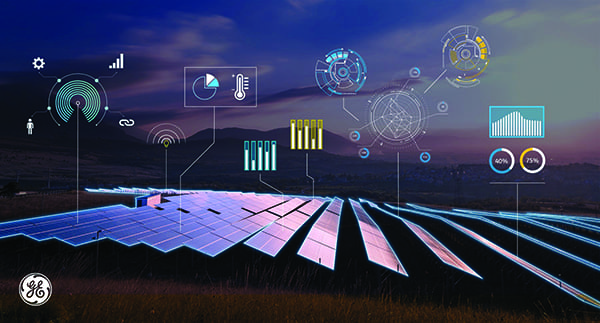The solar industry has the opportunity to integrate intelligent technology, including some that was originally developed for conventional energy resources, into its solar systems. Most parts of a solar farm are already computerized and collecting massive amounts of data. However, the utilization of that data to build predictive capabilities remains largely untapped. That doesn't have to be the case.
Nearly every part of every solar farm in the world is currently collecting massive amounts of data, and in nearly all cases, nothing significant is being done with it. "The gas world is way more sophisticated than the solar world today, but even they aren't in the analytic space," Azeez Mohammed, president and CEO of GE Power Conversion, said during a September 13 keynote presentation at the Solar Power International conference in Las Vegas (Figure 1). "In the solar side, we are still at phase zero."
That's not to say that no work has been done to integrate the internet of things (IoT), artificial intelligence, and machine learning into the industry. GE is working to develop predictive maintenance capabilities via digital twins, and the solar products company SunLink has developed an intelligent torque rod that can cut production costs for its tracking systems and software that has the potential to cut operations and maintenance costs.
Connecting solar plants is of particular importance due to their size, Mohammed said, pointing out the most basic logistical differences between a solar farm and a gas plant. While a gas plant has a lot of moving parts, they're all in the same relative location. It wouldn't take long to walk through the entire plant to investigate a problem.
"This is extremely important, especially for solar plants. If you take a 1-GW solar plant–a gas plant and solar plant–I can walk this whole [gas] plant," he said. "I can just walk around the perimeter. I can check what's going on … Try doing the same thing with 3,000 acres. You can run a few marathons."
The location of many utility-scale power plants also makes it critical that the solar industry adopt intelligent technology. Many utility-scale solar plants are located hours into the desert, making them hard to get too if anything goes wrong. The ability to predict problems and correct them remotely would be extremely helpful.
Digital Twins
One way to utilize the data collected by a solar plant's individual components is to create a digital twin (Figure 2). Mohammed presented an example in Las Vegas. The twin that he presented was looking specifically at the solar farm's inverters. "What it does is it makes an analytical model. It knows how this model has to behave in [certain] conditions; then it looks at the actual performance of these assets in the field. It compares both of them and is able to give some predictive warning capabilities," he said.
The use of the digital twin is somewhat limited. For example, it can't prevent any failures from happening, but it can help plant operators plan for future maintenance. The digital twin uses data from the solar farm it is modeling as well as historical data from tens of thousands of other assets. It is then able to run simulations of certain situations and use machine-learning to determine how to maximize the performance of the plant in those situations. The twin also creates a perfect version of the plant to use as a baseline, helping operators determine if the plant is running less efficiently than it should, and why.
If the digital twin identifies a problem, operators can better determine what maintenance must be done, and they have a little more leeway deciding when and how to perform that maintenance. "I think this is really the future," Mohammed said. "You are able to plan better. You are able to position the parts better. You don't need to bring the plants down for planned maintenance, you can do more of a predictive maintenance."
GE announced in mid-September that its digital twin technology is going to be deployed at a 20-MW solar farm being built by Invenergy. "We see this like a morning newspaper," Matt Perkins, chief digital officer of GE Power Conversion, said. "Plant managers can open it up in the morning and see the issues that they will need to deal with during the day. They can monitor existing problems and optimize the selection of staff members who are qualified to fix them."
The Invenergy plant will be equipped with GE inverters with sensors that monitor 200 different pieces of data. The sensors monitor things like component temperature and voltage. The data is updated every 500 microseconds to a data-collection device that feeds it into the cloud. The data is then gathered by the digital twin platform, which cleans and analyzes it.
GE's technology has been deployed at smaller solar plants, and similar technology has been deployed at some of Invenergy's gas and wind plants.
Cost-Cutting Dynamic Design
SunLink took a different approach to integrating intelligent technology into its products, focusing on how it could improve the solar industry by refining a single component.
One of the main concerns SunLink was looking to address was cost. "Not everyone's going to appreciate all the capabilities that you need, but what do they really value? Right now, everything is about cost," SunLink CEO Michael Maulick told POWER.
SunLink developed a new type of torque tube for its tracking systems (Figure 3), which allowed a significant production cost reduction. The torque tube works similarly to an advanced vehicle shock absorber, according to Maulick. The shock absorbers are connected to technology that reads the road ahead and can detect potholes. If a pothole is detected, the technology tells the shock absorber what to do to minimize impact, Maulick explained.
Similarly, SunLink's torque tube is connected to technology that reads the situation around it and tells the tube to either stiffen or weaken as needed. This is useful, for example, in cases of heavy snowfall. While other tracking systems need to be designed to hold very heavy snow loads, SunLink's software will register the snow load and direct the torque tube to go limp, dumping the load. "It's almost intuitively obvious, but to an industry that's doing things the same way that they always did them, they don't think of that," Maulick said.
By designing its torque tube to react to the environment, SunLink was able to cut costs for the component significantly. Because the tube is designed to drop loads before they get too heavy, they do not need to be designed to support as much weight as a basic torque tube, and they can be made with less steel.
"Sixty-two percent of the cost of a tracker system is in a single component, this main torque tube in the center of the system," Maulick explained. "I'm actually able to reduce the amounts of steel that are in that main component by one-fifth; that's huge in the cost structure. … By stepping back and looking at the problem the way we do, I have continued to bring down that pricing by introducing the dynamic design element."
The solar industry is rife with opportunity for the integration of intelligent technology. What remains uncertain is how long it will take for the industry to seize those opportunities. GE and SunLink hope the answer is soon. "I really believe this is the way to go," Mohammed said. ■
–Abby L. Harvey is a POWER reporter.



